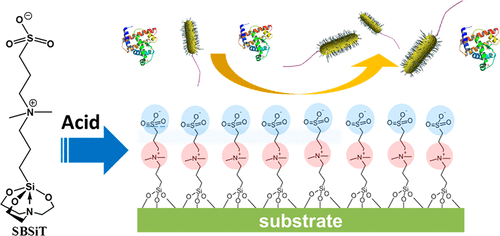Our official English website, www.x-mol.net, welcomes your
feedback! (Note: you will need to create a separate account there.)
Controlled Silanization Using Functional Silatrane for Thin and Homogeneous Antifouling Coatings
Langmuir ( IF 3.7 ) Pub Date : 2018-08-07 00:00:00 , DOI: 10.1021/acs.langmuir.8b01981 Chun-Jen Huang , Ya-Yun Zheng
Langmuir ( IF 3.7 ) Pub Date : 2018-08-07 00:00:00 , DOI: 10.1021/acs.langmuir.8b01981 Chun-Jen Huang , Ya-Yun Zheng

|
Organosilicons for surface modification are gaining prominence because of their easy and rapid preparation, high availability, and effective modification for varying interfacial properties. However, their implementation has been humbled by poor control of the packing density, thickness, and molecular structures due to the uncontrollable hydrolysis and condensation. This study reports for the first time new functional silatrane chemistry for the precision deposition of a thin and homogeneous zwitterionic coating. Sulfobetaine silatrane (SBSiT) has a tricyclic caged structure and a transannular N → Si dative bond, which shows excellent chemical stability in the presence of water and an acid-modulated hydrolysis characteristic. Results from X-ray photoelectron spectroscopy indicate the progressive deposition of SBSiT on a silicon surface. Characterization using atomic force microscopy and ellipsometry shows the uniform and thin SBSiT films on silicon surfaces. The superior antifouling properties of SBSiT coatings were demonstrated by resisting bacterial and protein adsorption. More importantly, the stable and complete formation of the SBSiT coatings allows an accurate interpretation of the interfacial phenomena for sensing and nanomaterial applications.
中文翻译:

使用功能性Silatrane的受控硅烷化,用于薄而均匀的防污涂料
用于表面改性的有机硅因其易于制备,快速制备,高可用性以及对各种界面特性的有效改性而日益受到关注。然而,由于不可控制的水解和缩合,对填充密度,厚度和分子结构的不良控制使它们的实施受到阻碍。这项研究首次报道了用于薄而均质两性离子涂层精密沉积的新型功能性硅烷基硅烷化学。磺基甜菜碱甲硅烷基(SBSiT)具有三环笼状结构和跨环N→Si配位键,在水存在下显示出优异的化学稳定性和酸调节的水解特性。X射线光电子能谱的结果表明,SBSiT在硅表面上逐渐沉积。使用原子力显微镜和椭圆光度法进行的表征显示出硅表面上均匀且薄的SBSiT膜。SBSiT涂层具有出色的防污性能,可抵抗细菌和蛋白质的吸附。更重要的是,SBSiT涂层的稳定而完整的形成可以准确解释传感和纳米材料应用中的界面现象。
更新日期:2018-08-07
中文翻译:

使用功能性Silatrane的受控硅烷化,用于薄而均匀的防污涂料
用于表面改性的有机硅因其易于制备,快速制备,高可用性以及对各种界面特性的有效改性而日益受到关注。然而,由于不可控制的水解和缩合,对填充密度,厚度和分子结构的不良控制使它们的实施受到阻碍。这项研究首次报道了用于薄而均质两性离子涂层精密沉积的新型功能性硅烷基硅烷化学。磺基甜菜碱甲硅烷基(SBSiT)具有三环笼状结构和跨环N→Si配位键,在水存在下显示出优异的化学稳定性和酸调节的水解特性。X射线光电子能谱的结果表明,SBSiT在硅表面上逐渐沉积。使用原子力显微镜和椭圆光度法进行的表征显示出硅表面上均匀且薄的SBSiT膜。SBSiT涂层具有出色的防污性能,可抵抗细菌和蛋白质的吸附。更重要的是,SBSiT涂层的稳定而完整的形成可以准确解释传感和纳米材料应用中的界面现象。















































 京公网安备 11010802027423号
京公网安备 11010802027423号